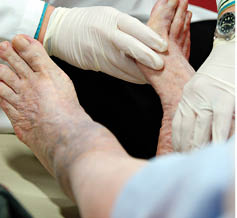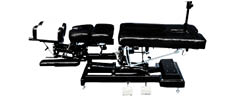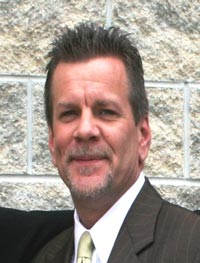Chiropractic America, LLC:
Delivering the Chiropractic Message in a Professional and Credible Manner
by Herb Newborg, D.C.
TAC: Could you tell our readers about how you became involved in Chiropractic America?
NEWBORG: I discovered chiropractic care through a very serendipitous route. I took a much needed vacation at a holistic resort. Spending several weeks eating healthy, organic foods and hearing from a leader in the raw food movement prompted me to embark on some research of my own into how my diet and that of my family might be causing some of the health challenges we faced. At the time, my wife was on 5 different prescription drugs, my 15-year-old was on 4 different medications for asthma. Doctors wanted to put my 8-year-old on medicine for “pre asthma” and my oldest son had just been prescribed Prozac. And all of these prescriptions were for drugs they were told they would need to take for the rest of their lives. I knew something was wrong with the advice we were receiving.
So, after much investigation, I found out that there was a third discipline of health care beyond the MD’s and DO’s (that until that time I had trusted for health care advice) called DC’s.
After several months of chiropractic care, they were off all medications and I felt better than I had in years. I wanted everyone to know the amazing turnaround my family and I experienced and began to share my story with everyone I knew. But I found out that there was so much misinformation and negative information in the public arena, it was difficult for me to convince others to get under care.
So, I contacted my neighbor in the business park where my computer company had been located who headed up a company called Chiropractic America. Within 2 weeks, I reached an agreement to buy the company. I then spent the next three years building and refining a program to finally take the chiropractic message to the public in a professional and credible manner. The result is Chiropractic America 2.0 and the YourSpine.com initiative.
TAC: So could you tell us a bit more about what Chiropractic America is offering DC’s today, in getting their message out there?
NEWBORG: The simple fact is chiropractic has no representation in the main stream media and no organized plan of action to properly present chiropractic to consumers on the Internet. We address both of these deficits with one integrated solution.
We engaged the top health care public relations firm in the country and worked with them to formulate a plan to reach consumers with the chiropractic message. They developed a thought leadership campaign to present Chiropractic America’s Advisory Council members to major media outlets to provide commentary and leadership on key trends in healthcare—drug safety, sleep habits, reimbursement and drug pricing, nutrition and obesity, etc.—where the perspective of the chiropractic community is relevant and will call attention to the value of chiropractic in addressing key health system issues. Every media opportunity is a chance to promote chiropractic and this high profile publicity drives consumers to the web site for additional information.
It turns out there are 10 million Internet users searching for health information each day in the US. We know exactly how they conduct their searches. We also know that there is absolutely nothing currently being done to reach them. So, the PR firm designed our site and the Internet advertising plan that supports it to put the chiropractic message in front of these 10 million consumers at the exact moment they are in need of care.
We have the top heath care PR firm in the country, the same firm that represents all of the major drug houses, poised to promote chiropractic with the same media savvy and professionalism that our health care competitors enjoy. We have the top web site developers, Internet and search engine marketing experts and pay-per-click campaign managers in place and ready to do what has never before been possible, to reach those in need of care at the exact moment they are deciding where to go for that care.
TAC: How will doctors be able to track the results associated with signing up for the new Chiropractic America program?
NEWBORG: We can track everything, from the ad text that draws them into the page they land at to the wording and images on the page through to the call to the doctor’s office. We, then, continually test and refine as we go to optimize our effectiveness. We give the doctor a report each month with the exact number of calls they received into their office. The whole process is completely scientific and will only get more efficient with time. The only thing left is to find the lucky doctor in each zip code that gets to participate, as we can only represent one doctor per zip code. We do this because there has to be a direct benefit to those that fund the program, or there is no incentive to participate.
 Herb Newborg is president of Chiropractic America. Chiropractic America and Ogilvy PR Worldwide firm, Feinstein Kean Healthcare (FKH) have developed a national marketing communications program centered on www.YourSpine.com a website designed to educate patients about the importance of spinal health. You can reach him at 1-215-310-1735 or 1-877-846-8544.
Herb Newborg is president of Chiropractic America. Chiropractic America and Ogilvy PR Worldwide firm, Feinstein Kean Healthcare (FKH) have developed a national marketing communications program centered on www.YourSpine.com a website designed to educate patients about the importance of spinal health. You can reach him at 1-215-310-1735 or 1-877-846-8544.
 There are three major types of neuropathy: post-chemo, diabetic related, and idiopathic. There are also other ways to get neuropathy – mono neural neuropathies that are a result of trauma, and disease-related neuropathies that are a result of other illnesses such as Guillain Barre, Charcot Marie Tooth, and multiple sclerosis. I am only going to address the more common neuropathies associated with diabetes, post-chemo, and idiopathic because of their similarity in pathology and because they are so prevalent in our society.
There are three major types of neuropathy: post-chemo, diabetic related, and idiopathic. There are also other ways to get neuropathy – mono neural neuropathies that are a result of trauma, and disease-related neuropathies that are a result of other illnesses such as Guillain Barre, Charcot Marie Tooth, and multiple sclerosis. I am only going to address the more common neuropathies associated with diabetes, post-chemo, and idiopathic because of their similarity in pathology and because they are so prevalent in our society.



 Herb Newborg is president of Chiropractic America. Chiropractic America and Ogilvy PR Worldwide firm, Feinstein Kean Healthcare (FKH) have developed a national marketing communications program centered on
Herb Newborg is president of Chiropractic America. Chiropractic America and Ogilvy PR Worldwide firm, Feinstein Kean Healthcare (FKH) have developed a national marketing communications program centered on